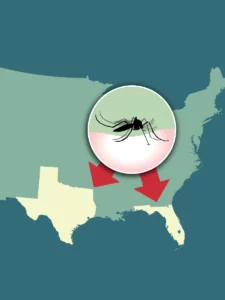Malaria cases in the US are on the rise: Your visual guide to symptoms and prevention!

At least seven cases of locally acquired malaria have been reported in the US over the past two months, the first time the disease has had a local spread in 20 years.
A public health alert was issued by the Centers for Disease Control and Prevention in June to advise doctors, public health authorities and the public about the risk.
Six of the cases were identified in Sarasota County, Florida, and one was identified in Cameron County, Texas. None of the patients had traveled outside the state before falling ill…
Malaria was declared eliminated as a major national public health problem in 1951. Now about 2,000 malaria cases are reported in the U.S. each year, typically in returning travelers. Florida and Texas identified 156 cases of malaria total in 2021; all were from returned travelers.
Rhoel Dinglasan, a professor of infectious diseases at the University of Florida’s College of Veterinary Medicine, told the Sarasota Herald-Tribune that cases of locally acquired malaria are not common. The last outbreak of malaria cases in the country was in 2003, when Palm Beach County recorded eight such cases.
Where is malaria most common?
Malaria is still a significant global problem even though it has been eradicated in many nations, including in the U.S., and there is no known method of transmission.
The majority of malaria cases and fatalities are found in Africa, where plasmodium faciparum, the most dangerous and widespread malaria parasite, is common. Only a few locations in other regions have transmission.
How is malaria spread?
Malaria is a serious and sometimes life-threatening disease caused by the bite of a female mosquito from the genus Anopheles, the vector that transmits malaria.
Most mosquitoes don’t carry disease. Those that do are called vectors. Among vector-borne diseases: West Nile virus, encephalitis, malaria, dengue fever and chikungunya in humans, or heartworm parasites in dogs.
When a mosquito bites
A stealth attack: A mosquito releases a substance in its saliva to numb the skin so people don’t feel its bite.
Infection: Viruses such as malaria are found in the mosquito’s saliva.
Feeding: A mosquito uses its proboscis to pierce the skin and locate a blood vessel. The mosquito releases substances that prevent blood from clotting so it can feed longer. Mosquitoes can feed up to 10 minutes.
The itch: The immune system releases histamine to fight the presence of the invading bodies in the skin. The skin swells, making a red itchy bump after a mosquito bite.
What are the signs and symptoms of malaria?
Chills, fever, headache, nausea, body aches and diarrhea are a few of the common malaria symptoms, which are similar to those of the flu, common cold and COVID-19.
The most common symptoms are fever, chills, headaches, muscle aches and fatigue. These symptoms typically occur seven to 30 days after people are infected with the parasite. However, if the infection is untreated, more severe symptoms may appear, including impaired consciousness, difficulty breathing, convulsions, abnormal bleeding and more, which can ultimately lead to death.



